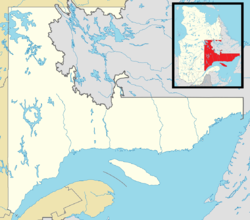Gros-Mécatina, Quebec
| Gros-Mécatina | |
|---|---|
| Municipality | |
 |
|
 Location within Le Golfe-du-Saint-Laurent RCM. |
|
| Location in Côte-Nord Region of Quebec. | |
| Coordinates: 50°50′N 58°58′W / 50.833°N 58.967°WCoordinates: 50°50′N 58°58′W / 50.833°N 58.967°W | |
| Country |
|
| Province |
|
| Region | Côte-Nord |
| RCM | Le Golfe-du-Saint-Laurent |
| Constituted | January 1, 1994 |
| Government | |
| • Mayor | Randy Jones |
| • Federal riding | Manicouagan |
| • Prov. riding | Duplessis |
| Area | |
| • Total | 1,388.20 km2 (535.99 sq mi) |
| • Land | 804.80 km2 (310.74 sq mi) |
| Highest elevation | 59 m (194 ft) |
| Lowest elevation | 0 m (0 ft) |
| Population (2016) | |
| • Total | 367 |
| • Density | 0.6/km2 (2/sq mi) |
| • Pop 2006-2011 |
|
| • Dwellings | 270 |
| Time zone | AST (UTC-4) |
| Postal code(s) | G0G 1T0 |
| Area code(s) | 418 and 581 |
| Highways | No major routes |
| GNBC Code | EPSNX |
| NTS Map | 012J15 |
The Municipality of Gros-Mécatina is on the Lower North Shore of the Gulf of Saint Lawrence, near the border with Labrador in Quebec, Canada. Located near excellent crab, lobster, and scallop fishing grounds, it is dependent on the fishing business, including a fish processing factory that contributes to regional economic activity.
The isolated municipality can only be reached via a regular weekly ferry service, or La Tabatière Airport. The villages of La Tabatière and Mutton Bay are connected via a 10 kilometres (6.2 mi) asphalted road that provides some spectacular views of the gulf from the mountains; but in the winter the road is not plowed, and the only access is via snowmobile.
The name, pronounced (me-kuh-TEE-nuh)is from the Innu word makatinau, or "It is a large mountain."
Exploration of the area began in 1535 when Jacques Cartier passed by during his second voyage. The place became an important hunting and fishing ground in the first part of the 18th century. From 1739, Jean-Baptiste Pommereau acquired the fishing rights of the region for a period of ten years. The Gros-Mécatina Post, built in the same time period near present-day La Tabatière, quickly became one of the most important fishing settlements of the North Shore. Big Mécatina Island also, granted to Intendant Gilles Hocquart in 1755, was a popular location with fishermen. They remained such until at least 1808 when the authorities of Quebec sold Gros-Mécatina. By then permanent settlement had begun.
The Municipality of Gros-Mécatina was formed on January 1, 1994, when its territory was separated from the Municipality of Côte-Nord-du-Golfe-Saint-Laurent. It was named after several geographic features within its area called Gros Mécatina, including a river, cape, island, archipelago, and lake. Mecatina comes from the Innu word makatinau, meaning "large mountain."
The municipality consists of two small isolated fishing villages, La Tabatière and Mutton Bay, as well as the abandoned settlements of Lac-Salé and Baie-des-Ha!-Ha! (Baie de la Terre).
La Tabatière (50°49′45″N 58°57′38″W / 50.82917°N 58.96056°W) is located on La Tabatière Bay, opposite Big Mecatina Island (île du Gros Mécatina), and home to a fish processing plant and reservoirs to supply vessels that serve this part of the region. According to popular opinion, the origin of its name (French for "the snuff box") refers to the loss of a tobacco pouch by a missionary. However, it is a corruption of tabaquen, possibly Innu, which became tapatienne and then tabatière. Missionary correspondence shows that the parish was at one time often referred to as Saint-Joseph-de-Tabaquen, a name said to mean "sorcery," and a priest who visited the mission in 1887 wrote that aboriginal groups who came to trade would consult a "sorcerer-magician" before leaving for their camps in the interior forests to find out the prospects for their return trip.
...
Wikipedia

